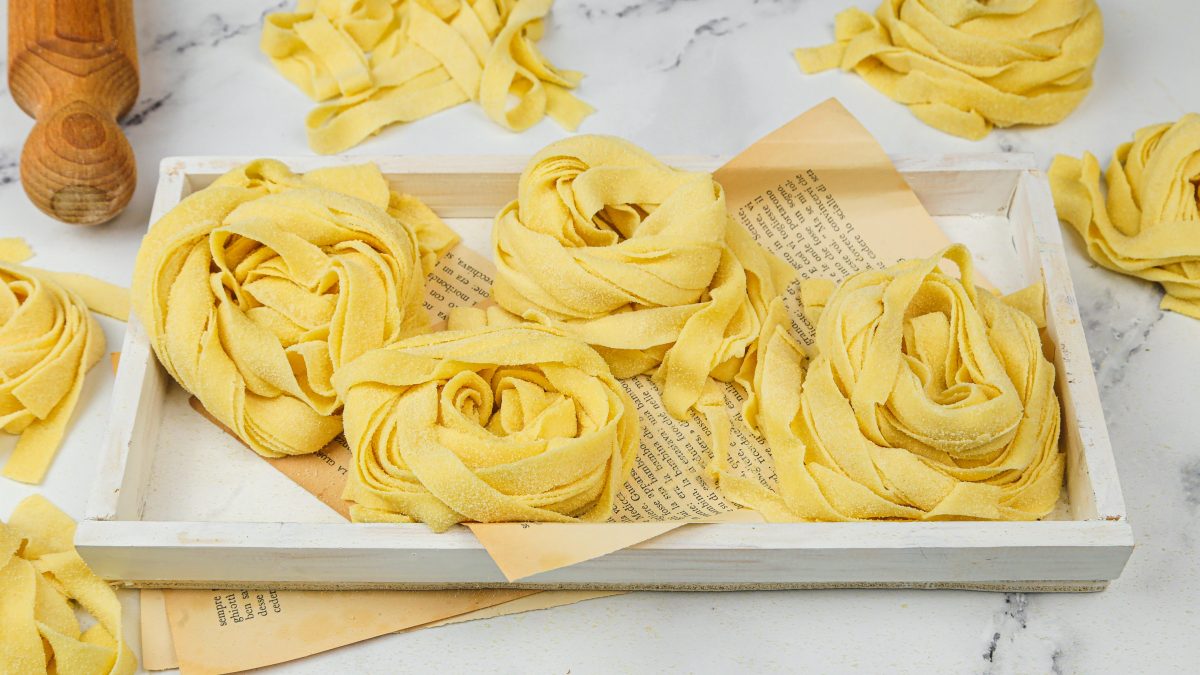
Homemade Eggless Tagliatelle Pasta is a very simple and quick basic preparation, a valid alternative to classic fresh egg pasta, perfect for those who are intolerant to this ingredient or follow a vegan diet.
This fresh pasta is prepared by working the re-milled durum wheat semolina flour with a pinch of fine salt and hot water, until obtaining an elastic and compact dough; this should be wrapped in cling film and left to rest in the refrigerator for 30 minutes before being rolled out into thin sheets with a rolling pin or with a more practical pasta machine.
With the recipe we propose you can make different pasta shapes according to your tastes: we have prepared the classic tagliatelle, but you can also make pappardelle and fettuccine, cannelloni, cavatelli, orecchiette and lasagne.
What is Eggless Homemade Pasta?
Eggless pasta has deep roots in regional Italian culinary traditions, particularly in southern Italy where durum wheat semolina and water were readily available, but eggs were often a luxury. This style of pasta was prized for its simplicity and resilience, forming the backbone of dishes in rustic kitchens from Puglia to Sicily. As Italian immigrants arrived in the United States in the late 19th and early 20th centuries, they brought their diverse pasta-making traditions with them. While many Italian-American households adapted to the egg-rich pasta styles popular in northern Italy, eggless pasta persisted, especially among those who valued traditional, frugal cooking methods or adhered to dietary restrictions. Over time, as plant-based diets gained popularity, eggless pasta saw a resurgence in the U.S., embraced not just for its cultural authenticity, but also for its vegan-friendly appeal and versatility in modern cuisine.
Pro Tips for The Best Homemade Eggless Pasta
- To give fresh eggless pasta a more intense color, you can add a pinch of turmeric or saffron powder.
- In addition, you can flavor the dough by adding cooked spinach, chopped and dried with a cloth, to give the pasta a truly particular color and flavor.
- We recommend choosing a cool, draft-free work environment so that the dough remains moist while you work it. In any case, cut one piece of dough at a time and always cover the rest of the dough with a cloth.
- If you don't have a pasta machine, you can use a rolling pin, taking care to roll out the dough very thinly. Sprinkle plenty of semolina flour on your work surface before cutting the pasta sheets.
Does Homemade Pasta Always Need Eggs?
Homemade pasta doesn’t always require eggs. In southern Italy, eggless pasta made with just semolina flour and water is a longstanding tradition, especially for firmer shapes like orecchiette and cavatelli. While egg-based dough is common in northern Italy for softer, richer types like fettuccine or ravioli, eggless versions are ideal for vegan diets, firmer textures, and shaped pastas. Whether or not to use eggs depends on the pasta style, regional traditions, and personal preference.
What is The Best Type of Flour to Use for This Pasta?
The best one is the one we used, re-milled durum wheat semolina. But, if you do not have re-milled durum wheat semolina, you can use type 0 flour in the same doses. The result will be a lighter but still very elastic pasta. Remember that each flour has a different degree of absorption and, for this reason, we recommend adding water a little at a time, checking the consistency of the dough.
How Thin Should My Pasta Be?
When shaping eggless pasta into tagliatelle, aim for a thickness of about 1 to 1.5 millimeters—roughly the thickness of a credit card. This ensures the pasta cooks evenly and maintains the right bite. Because eggless dough is a bit firmer than egg-based versions, rolling it too thick can make it chewy, while too thin may cause it to tear. If using a pasta machine, stop at the second-to-last setting for optimal results.
Why is My Pasta Dough Falling Apart?
If your pasta dough is falling apart, it’s likely too dry or under-kneaded. Eggless dough, especially with semolina, needs just the right moisture to bind—add a few drops of water if it's crumbly.
Also, knead it thoroughly (at least 8–10 minutes) to develop the gluten, which gives the dough elasticity and cohesion. Letting it rest for 30 minutes wrapped in plastic helps it hydrate fully and become easier to work with.
How Long Will It Take to Cook?
Homemade eggless tagliatelle pasta cooks in boiling water for about 6-8 minutes.
What Can I Use This Pasta For?
Fresh egg-free pasta, thanks to its rougher and more porous consistency compared to the traditional recipe, is ideal for seasoning with a simple fresh tomato sauce, a tasty vegetable ragù or other vegan ragùs such as the soy and lentil variants. You can also enjoy it with traditional Italian classics, such as ragù alla bolognese, pesto alla genovese and ragù alla napoletana.
Can I Make it Ahead of Time?
Yes, you can make eggless pasta ahead of time! After shaping it, dust it lightly with flour to prevent sticking, then let it air-dry for up to 24 hours at room temperature or store it in the fridge for up to 2 days in a sealed container.
Does It Freeze Well?
Yes! You can freeze and cook it when needed. To freeze it, simply place the fresh pasta on a tray sprinkled with semolina and place in the freezer for at least two hours. After this time, you can place the fresh pasta in airtight bags and keep them in the freezer for about 2 months.
How to Store Leftovers
Fresh pasta without eggs can be stored in the refrigerator for 2 days, tightly closed in an airtight container and sprinkled with plenty of re-milled semolina flour.
Ingredients
How to Make Homemade Eggless Pasta
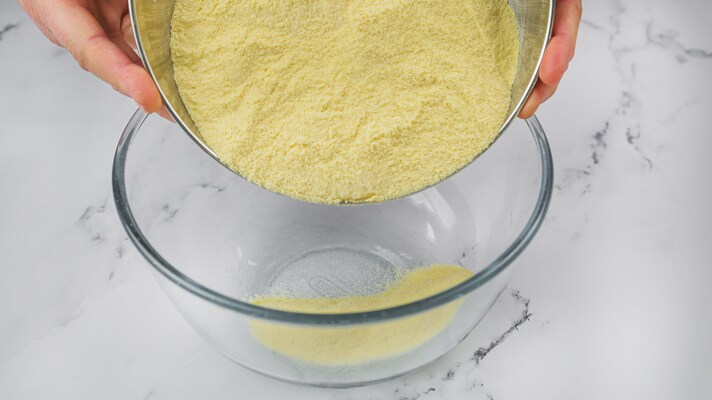
Pour the durum wheat semolina flour into a large bowl.
Pour the durum wheat semolina flour into a large bowl.
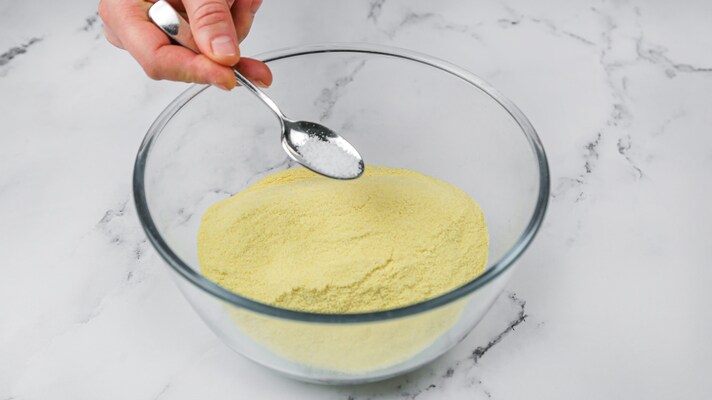
Add fine salt.
Add fine salt.
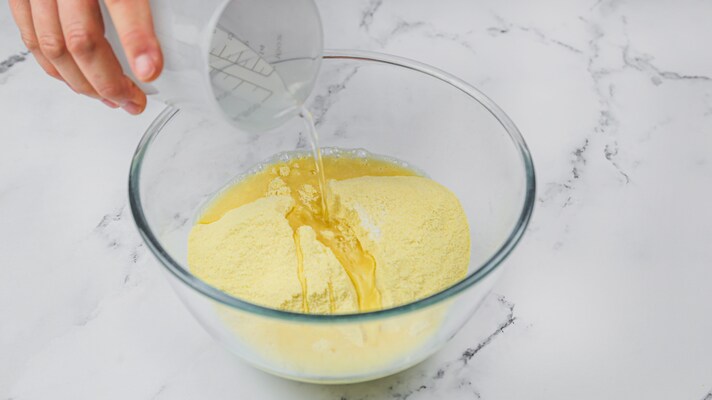
Gradually pour in the hot water.
Gradually pour in the hot water.
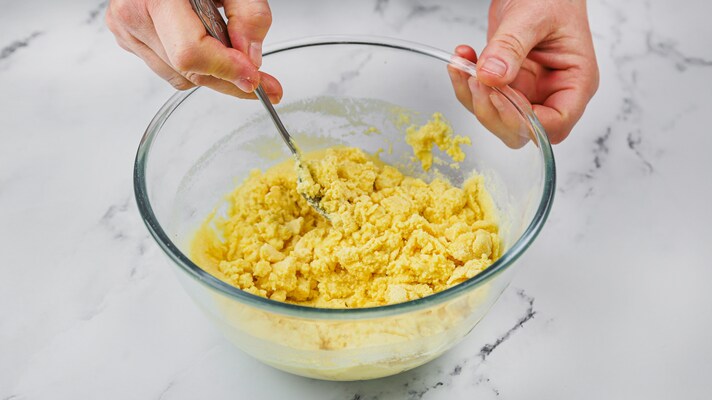
Knead with a fork for a few minutes, until you get a grainy mixture.
Knead with a fork for a few minutes, until you get a grainy mixture.
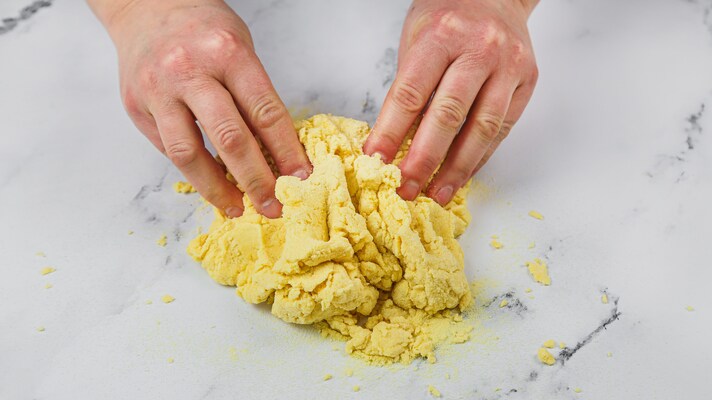
Transfer the dough onto a lightly floured surface and work quickly with your hands.
Transfer the dough onto a lightly floured surface and work quickly with your hands.
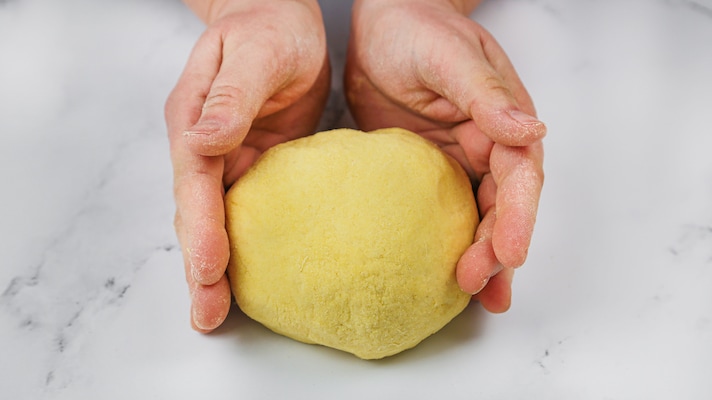
You should get a smooth and elastic dough. If the dough is too soft, add a little more flour. On the contrary, if it is too dry, slightly increase the amount of hot water; wrap the dough in cling film and let it rest for 30 minutes.
You should get a smooth and elastic dough. If the dough is too soft, add a little more flour. On the contrary, if it is too dry, slightly increase the amount of hot water; wrap the dough in cling film and let it rest for 30 minutes.

Take the dough and roll it out with a rolling pin until you obtain a sheet of dough about 3-4 mm thick.
Take the dough and roll it out with a rolling pin until you obtain a sheet of dough about 3-4 mm thick.
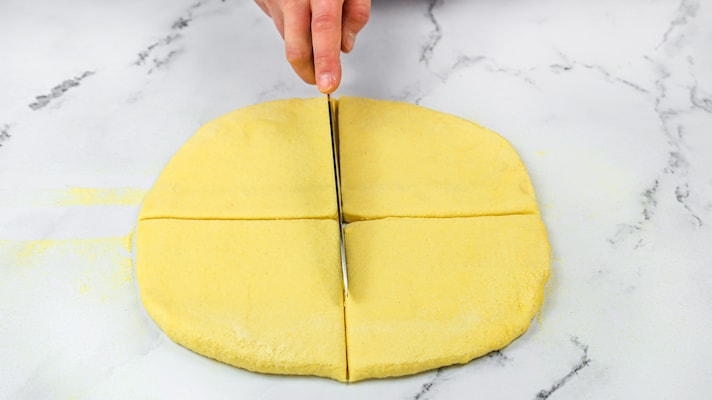
Divide the dough into four parts.
Divide the dough into four parts.
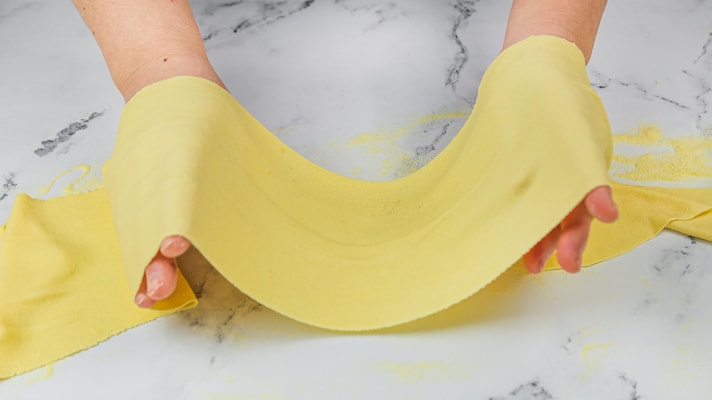
Pass a portion of dough through the pasta machine until you obtain a thin sheet. To do this, you need to pass the dough through several times.
Pass a portion of dough through the pasta machine until you obtain a thin sheet. To do this, you need to pass the dough through several times.
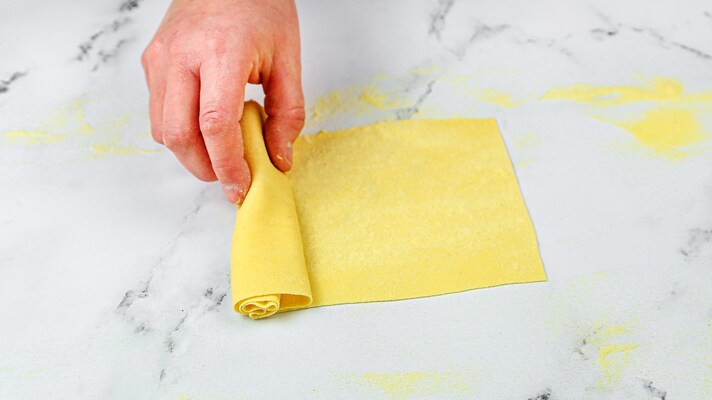
Fold each sheet of pastry over itself and form a roll.
Fold each sheet of pastry over itself and form a roll.
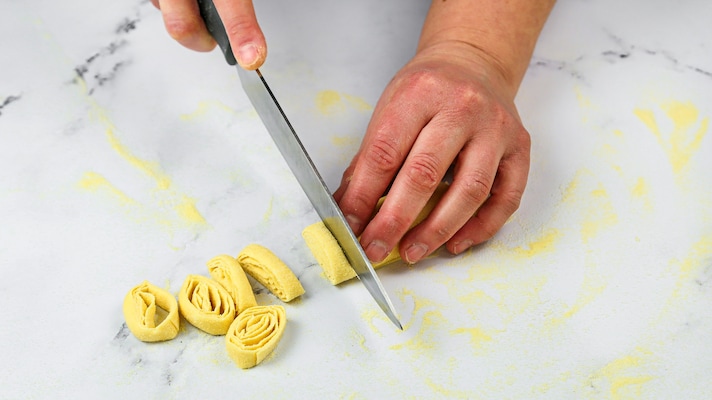
Flatten the roll slightly with your hands and then use a sharp knife to cut out strips of about 8 mm.
Flatten the roll slightly with your hands and then use a sharp knife to cut out strips of about 8 mm.
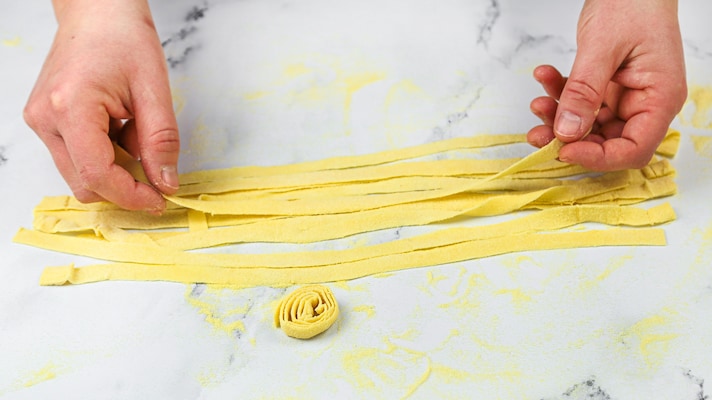
Gently separate the strips obtained by taking them from the ends and place them on a work surface, lightly dusted with semolina.
Gently separate the strips obtained by taking them from the ends and place them on a work surface, lightly dusted with semolina.
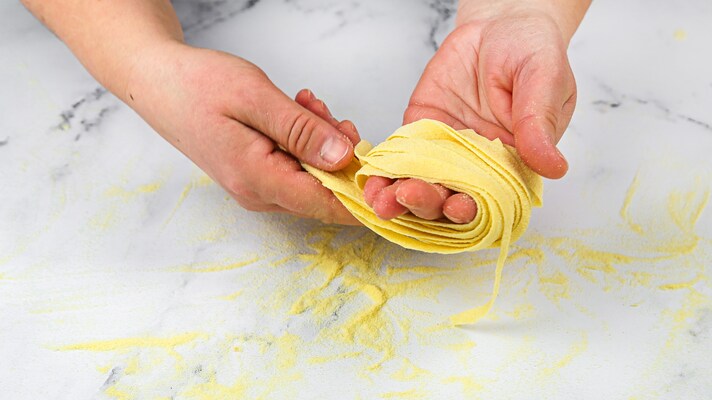
Collect a few strips and roll them in the palm of your hand to form a nest.
Collect a few strips and roll them in the palm of your hand to form a nest.
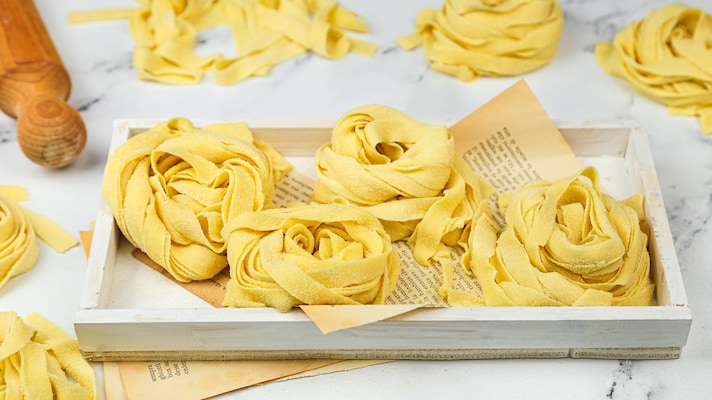
Your eggless pasta is ready to be cooked as you like!
Your eggless pasta is ready to be cooked as you like!
;Resize,width=767;)
